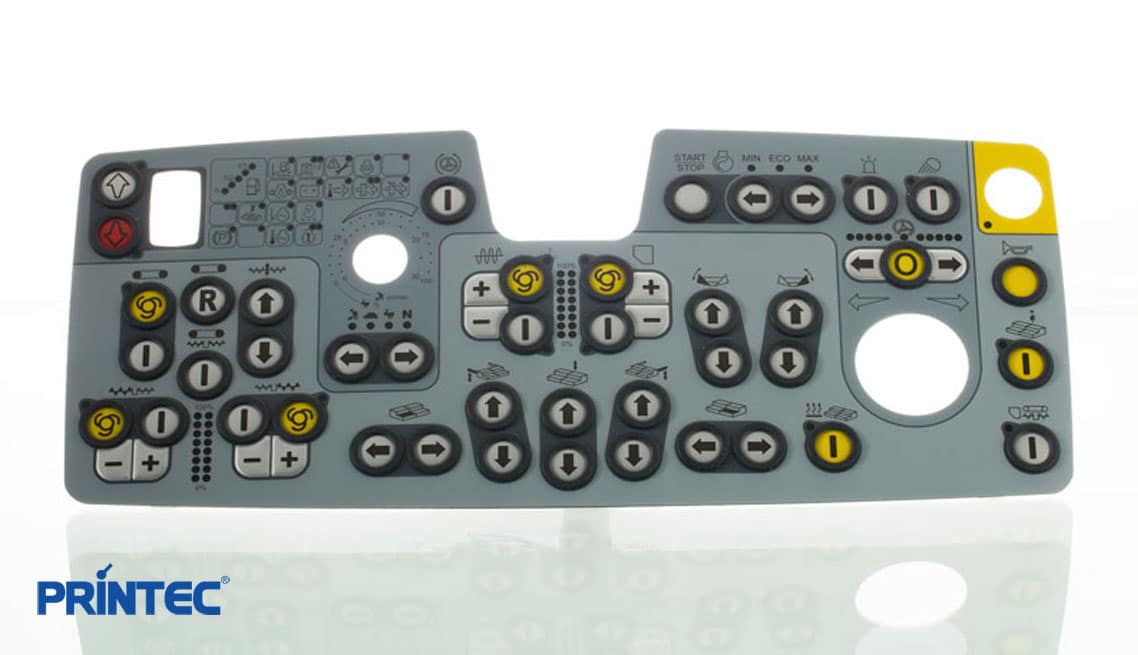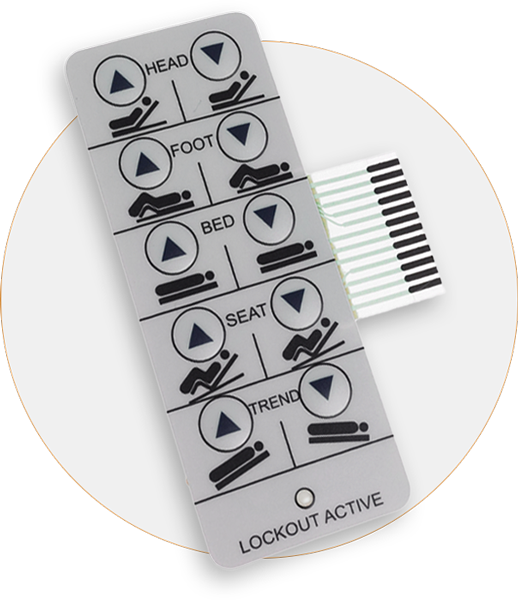All Regarding Membrane Layer Switch Over: Comprehending Its Design and Capability
When you assume concerning the control interfaces in modern-day devices, membrane buttons usually come to mind. Allow's discover what sets membrane switches apart from other control systems.
What Are Membrane Layer Buttons?

Their seamless nature makes them easy to clean and resistant to dust and moisture, an important feature in numerous atmospheres. Membrane switches can additionally be tailored pertaining to form, dimension, and graphics, allowing suppliers to develop one-of-a-kind user interfaces customized to certain items. Plus, they're lightweight and thin, which aids in lessening the general bulk of devices. Overall, membrane switches play a significant role in boosting user experience throughout a large range of applications.
How Membrane Switches Over Work
When you push a secret on a membrane layer button, it triggers a straightforward yet reliable mechanism. The leading layer, often constructed from versatile product, pushes down onto a conductive layer below it. This action bridges the space between conductive traces, completing an electric circuit. As soon as the circuit shuts, it sends a signal to the device's controller, which analyzes your input.
You'll discover that the responsive responses varies based on the button layout, providing either a soft click or a much more noticable response. Once you release the secret, the membrane layer returns to its original placement, reopening the circuit and stopping the signal. This procedure happens practically immediately, making sure a responsive user experience.
Membrane switches are prominent as a result of their sturdiness and resistance to dust and moisture, making them suitable for numerous applications, from household home appliances to medical devices. Comprehending this procedure aids you value their widespread use.
Secret Parts of Membrane Layer Buttons
Comprehending the crucial parts of membrane layer buttons is essential for grasping their functionality and style. At the core, you'll discover the graphic overlay, which gives the aesthetic user interface for customers. Under that, there's a spacer layer that divides the circuit layers, making certain that they don't make contact until pressed. The circuit layer is where the magic happens; it contains conductive traces that complete the circuit when you push the switch. One more crucial component is the adhesive support, enabling the button to stick to surface areas safely. The safety layer shields versus ecological factors and put on, extending the button's lifespan. Each part plays a significant role in making sure dependable efficiency and individual communication. By understanding these elements, you'll get insight right into just how membrane switches run and their value in numerous applications.
Products Utilized in Membrane Layer Change Layout
The performance and durability of membrane layer switches over greatly depend upon the products made use of in their style. You normally encounter polyester and polycarbonate as key substrates as a result of their exceptional strength and flexibility. These materials stand up to scratches and chemicals, making them optimal for requiring settings.
The conductive layers commonly utilize silver or carbon, selected for their dependability and conductivity. membrane switch manufacturer. Silver gives premium performance, while carbon is a cost-efficient choice. For the overlay, you could take into consideration a matte or shiny surface, depending upon your aesthetic requirements and individual experience
Adhesives play an important function also; they bond layers firmly and ensure longevity. Make sure to select adhesives that hold up against environmental variables like temperature level and moisture. Ultimately, don't forget the significance of a great printing method for graphics, as it improves both capability and visual charm. Picking the best products will certainly ensure your membrane layer switch stands the test of time.
Layout Factors To Consider for Membrane Layer Switches
While making membrane buttons, it's essential to take right into account various factors that affect their functionality and customer experience. Beginning by concentrating on the design and button size; make sure they're user-friendly and easy to browse. Think about the tactile responses you wish to supply-- will users need a recognizable click or a softer touch? Additionally, think of the products you'll make use of, as they'll affect longevity and visual appeals.
Do not neglect the visuals layout; clear labeling and color contrast are considerable for exposure. Verify your layout fits environmental factors, like wetness or temperature variations, which might affect performance. Ultimately, keep in mind the value of screening models with actual individuals to collect comments and make required adjustments. This iterative process aids you improve the style, validating it satisfies both useful and aesthetic demands successfully. By thoroughly considering these components, you'll produce a membrane layer switch that improves usability and complete satisfaction.
Applications of Membrane Layer Buttons
Membrane layer buttons are functional parts located in various applications, from industrial equipment to customer electronic devices. You'll see their influence in equipments that call for long lasting interfaces and in devices that take advantage of sleek designs. Understanding these applications aids you appreciate the functionality and practicality of membrane layer buttons in daily innovation.
Industrial Tools Use
When you're looking to enhance the performance of industrial tools, membrane switches use a trusted remedy that incorporates durability with straightforward style. These switches are best for rough environments, providing resistance to dirt, moisture, and chemicals. You'll locate them in control panels for manufacturing machines, cooling and heating systems, and medical tools, where precision and responsiveness are important. Their low account means they fit effortlessly into different equipment, conserving important room while preserving convenience of use. With customizable graphics and backlighting choices, you can develop an user-friendly user interface for operators, boosting performance and why not try here safety. And also, their lengthy lifespan reduces upkeep costs, making them a smart investment for your industrial applications. Welcome membrane buttons to streamline your operations and enhance general efficiency.
Customer Electronic Devices Integration
In the domain of consumer electronics, membrane buttons play an important role in enhancing user interaction click for source and gadget performance. Membrane layer buttons also ensure sturdiness and resistance to dust and dampness, expanding the lifespan of your electronics. By choosing membrane layer switches, you boost not simply the functionality but also the design of your devices, making daily communications smooth and delightful.
Advantages and Disadvantages of Membrane Layer Switches
While membrane buttons provide a variety of advantages, they also come with some drawbacks that you must consider. One substantial benefit is their compact style, making them optimal for space-constrained applications. They're likewise cost-efficient, providing a long lasting solution with a low manufacturing cost. In addition, their seamless surface is very easy to tidy, enhancing hygiene in settings like hospitals.

However, there are disadvantages. Membrane layer switches can have a shorter life expectancy contrasted to mechanical switches, especially under hefty usage. They can additionally be much less tactile, which may affect user comments during operation. Furthermore, if harmed, repairing them can be difficult and often calls for full substitute. Eventually, their level of sensitivity to extreme temperature levels and environmental problems may restrict their effectiveness in specific setups. Stabilizing these benefits and drawbacks will certainly assist you establish if membrane layer switches are the ideal suitable for your project.
Frequently Asked Questions
How Much Time Do Membrane Changes Commonly Last?
Membrane layer switches normally last in between 5 to one decade, relying on use and ecological problems. You'll intend over here to review variables like wear, exposure to wetness, and temperature level fluctuations to gauge their longevity effectively.
Can Membrane Switches Over Be Personalized for Certain Designs?
Yes, you can customize membrane buttons to fit specific styles (membrane switch manufacturer). You'll have the flexibility to choose colors, forms, and formats that match your job's needs, guaranteeing they mix seamlessly with your general visual
What Is the Price Range for Membrane Switch Manufacturing?
The cost array for membrane layer button manufacturing typically falls in between $1 and $10 per system, depending upon variables like style complexity, quantity, and materials. You can get quotes from makers to locate the most effective alternative.

Are Membrane Switches Water-proof or Resistant?
Membrane buttons can be designed to be water resistant or immune, depending upon materials made use of and building and construction methods. If you require them for wet settings, ensure you specify those requirements throughout the layout procedure.
Just How Do Membrane Layer Switches Compare to Standard Buttons?
Membrane switches are normally thinner and a lot more versatile than standard switches, using a streamlined design. They're usually much easier to cleanse and integrate, however could not give the responsive feedback you're used to with mechanical choices.
Verdict
